Living the Movie Wonder: How 13-Year-Old Nathaniel Found Freedom, Inspires Kindness
11.17.2017 | Seattle Children's Press Team
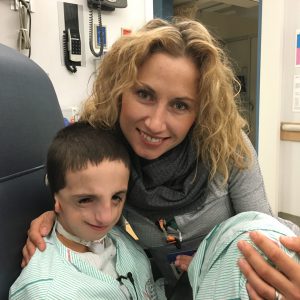 The movie “Wonder,” based on the New York Times bestseller, premiered worldwide today, and although the movie is fictional, the storyline sheds light on a rare craniofacial condition affecting one in 50,000 newborns: Treacher Collins syndrome.
The movie “Wonder,” based on the New York Times bestseller, premiered worldwide today, and although the movie is fictional, the storyline sheds light on a rare craniofacial condition affecting one in 50,000 newborns: Treacher Collins syndrome.
“Wonder” weaves together an inspiring tale of kindness, as viewers are transported into the world of August (Auggie) Pullman, an ordinary boy born with an extraordinary face. The story has captured the hearts of millions, but it hits particularly close to home for one Seattle-based family.
Nathaniel Newman, 13, and his family have no trouble relating to the storyline; they live it every day. Nathaniel was born with Treacher Collins Syndrome and has been called “Auggie Pullman come to life” by author R.J. Palacio.
Nathaniel knows what it’s like to walk in Auggie’s shoes. His message to others is simple. It echoes that of Auggie: Be kind.
Treacher Collins syndrome is a rare genetic condition that affects the way a child’s face develops, especially the cheekbones, jaws, ears and eyelids.
“Although the severity of the syndrome can vary from child to child, the facial characteristics of Treacher Collins syndrome are usually quite recognizable,” said Dr. Michael Cunningham, medical director of Seattle Children’s Craniofacial Center. “Children with Treacher Collins syndrome often have problems with breathing, swallowing, chewing, hearing and speech, however, they most commonly have normal development and they are often very creative and artistic. Medical providers that care for these children universally comment on what bright and engaging children they are.”
An unexpected journey
There was no indication anything was wrong with Russel and Magdalena (Magda) Newman’s baby prior to his delivery. So when they first laid their eyes on their baby boy, they were shocked.
“My wife and I describe it as the best and worst moment of our lives,” said Russel Newman. “I curled up on the floor crying as alarms and chaos ensued. Magda just kept asking, ‘What’s wrong with my baby?’”
It was hours before the Newman family were given a diagnosis. It was too surreal to comprehend.
Nathaniel was born without ears, or cheekbones, a small jaw and eyes that severely slanted downward.
“The focus in the beginning was simply on keeping Nathaniel alive,” said Newman. “At first, we were so consumed by the diagnosis it was easy to forget we’d just been given a gift, a blessing, and so in the midst of the craziness we tried to take a moment to enjoy and cherish our newborn child.”
Hospitals become the new norm
Children born with Treacher Collins syndrome require complex medical care. In Nathaniel’s first few weeks of life, the doctors at NYU Medical Center, the medical center closest to the family’s home in New Jersey, worked quickly to ensure he could breathe, eat and perform other basic life functions. At the time, his long-term prognosis was unclear.
Hospitals, doctors, nurses and surgeries became a normal component of Nathaniel’s life.
To date, Nathaniel has undergone nearly 60 different surgical procedures, according to Newman. He’s needed multiple procedures to enlarge his small jaw, surgeries to try and build a working airway and a variety of other procedures to improve everyday life functions.
A new medical home
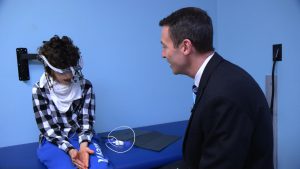 In 2016, Newman made a career move that brought his family to the West Coast.
In 2016, Newman made a career move that brought his family to the West Coast.
“For years, we were under the care of Dr. Joseph McCarthy at NYU Medical Center. We asked him, ‘If your grandchild had Treacher Collins where would you take him?’ He said to Dr. Richard Hopper at Seattle Children’s, and so when we moved out west it was a no-brainer where we would go,” said Newman.
The Newman family moved to Reno, Nevada, but commuted more than 700 miles to Seattle Children’s for medical care.
Seattle Children’s Craniofacial Center is the largest, most comprehensive craniofacial center in the country, and one of a select few centers in the U.S. that has every discipline necessary to provide customized care to meet the needs of any patient with a craniofacial diagnosis. The Center’s multidisciplinary approach brings together a team of more than 50 specialists who work together to diagnose and care for patients with craniofacial conditions.
Dreaming of independence
Throughout Nathaniel’s life, he’s overcome many things, but there was always one obstacle that seemed insurmountable: breathing without a tracheostomy.
At only 6 weeks old, Nathaniel had a tracheostomy placed. Doctors were unable to open Nathaniel’s airway wide enough to allow him to breathe normally, and so for 13 years his life was greatly limited by having a tracheostomy. This meant he could not swim or shower on his own, and he required a constant escort of nurses at school.
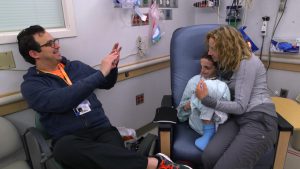 The Newman family had resigned to the fact that Nathaniel would be tracheostomy-dependent for the rest of his life. That was the reality that he faced until Dr. Richard Hopper, surgical director of Seattle Children’s Craniofacial Center, and the craniofacial team gave the family new hope.
The Newman family had resigned to the fact that Nathaniel would be tracheostomy-dependent for the rest of his life. That was the reality that he faced until Dr. Richard Hopper, surgical director of Seattle Children’s Craniofacial Center, and the craniofacial team gave the family new hope.
Hopper was in the midst of developing a revolutionary new surgery called subcranial rotation distraction, a procedure that could change the life of a child, like Nathaniel, who was tracheostomy-dependent.
“Children with a tracheostomy live in constant fear of this small plastic tube becoming dislodged or blocked with mucous, which can be life threatening,” said Dr. Kaalan Johnson, surgical director of the Aerodigestive Program at Seattle Children’s, who works with the craniofacial team to help treat children with tracheostomies. “It is a very stressful existence for a patient and their family, especially in very young children. Having a tracheotomy also makes important life experiences such as swimming, playing contact sports, or even sometimes speaking or swallowing more challenging and occasionally impossible.”
Seattle Children’s Craniofacial Center is the first in the world to use subcranial rotation distraction to improve the airway and jaw position in children with Treacher Collins syndrome. The first-of-its-kind procedure combines two procedures – surgery and distraction osteogenesis – to correct and rotate the position of the jaw to open up a child’s airway. The technique, now called counterclockwise craniofacial distraction osteogenesis (C3DO), was published in Plastic and Reconstructive Surgery.
“I’m grateful I’m able to work with a team able to achieve these kinds of life-changing results,” said Hopper. “This procedure will likely change the standard of care for children like Nathaniel.”
In March 2016, Nathaniel underwent the first, and most complex, in what would be a series of surgeries. During the surgery, Nathaniel’s entire face was separated from his skull base and his upper and lower jaws were wired shut. A distraction device was placed around his face to help swing his face forward in the weeks following the surgery.
“What Dr. Hopper was doing to help Nathaniel was uncharted territory,” said Newman. “Even with Nathaniel’s extensive surgical history, this was a new and scary time. Given the magnitude of the intervention Nathaniel needed, we kept asking ourselves if it was too much or if we were doing the right thing for our son. The self-doubt was intense, but as we got to know Dr. Hopper and his team, we knew, in the end, it would all work out.”
After a nearly twelve-hour surgery, Hopper had good news. The procedure was a success. The next few months would be difficult, but each day brought Nathaniel one step closer to freedom from his tracheostomy. Much like tightening braces on teeth, the device needed to be turned daily to slowly bring Nathaniel’s face forward and unlock his airway.
Months later, Nathaniel underwent a second surgery to release the wires locking his jaws. A third and final surgery removed the distractor and Hopper and his team used bone grafts from Nathaniel’s skull to construct cheek bones – something Nathaniel never had before.
A new lease on life
On January 26, 2017, the day they had long been waiting for finally arrived. Nathaniel’s tracheostomy was removed. He was able to breathe through an unobstructed airway for the first time in nearly 13 years. In 30 seconds, the tracheostomy that had been with Nathaniel his whole life was gone, and the hole in his neck was patched up with a simple bandage. Nathaniel’s father had tears streaming down his face.
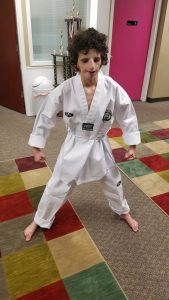 It was a monumental occasion worth celebrating, and so Seattle Children’s Craniofacial Team threw Nathaniel a party.
It was a monumental occasion worth celebrating, and so Seattle Children’s Craniofacial Team threw Nathaniel a party.
“There really are no words of appreciation that could adequately convey our feeling of gratitude,” said Newman. “We will be forever grateful to everyone at Seattle Children’s. My son has been cared for at many of the country’s top hospitals in cities from coast to coast. Seattle Children’s has been absolutely best in class.”
“I’m still amazed by Nathaniel’s transformation,” said Hopper. “It makes me feel humbled that I had a chance to work with them. It’s a great feeling to see a patient who was resigned to have a tracheostomy his entire life free from it.”
“He’s not just living, he’s thriving”
Nathaniel has been through a lot, but through it all he’s kept a positive attitude and an unparalleled sense of humor.
“He’s doing great!” said Newman. “His life has gained a newfound sense of normalcy we didn’t even realize we were missing until it was gone, and he is able to do things he’s never been able to do before like go swimming. He finally has freedom!”
Nathaniel started the 8th grade this year, a new chapter in his storyline. Typically, the Newman family would write a letter to Nathaniel’s teacher and fellow students describing Treacher Collins syndrome and the long medical journey Nathaniel has faced throughout his life. Below are excerpts from last year’s letter:
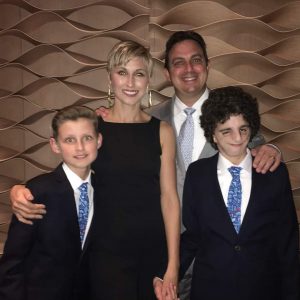 “I want to write you because I will be a new student and I am different. I don’t want you to be surprised when we meet. I know everyone is different but I have craniofacial differences. That means I look different than most kids. You may have read the book “Wonder.” If you have, then you already know a bit about me. I look a lot like you might think Auggie Pullman looks. I also have had similar experiences and feelings like you read about Auggie. I’ve read the book twice and even know the author pretty well.
“I want to write you because I will be a new student and I am different. I don’t want you to be surprised when we meet. I know everyone is different but I have craniofacial differences. That means I look different than most kids. You may have read the book “Wonder.” If you have, then you already know a bit about me. I look a lot like you might think Auggie Pullman looks. I also have had similar experiences and feelings like you read about Auggie. I’ve read the book twice and even know the author pretty well.
Now for the important part, I really want you to treat me just like everyone else. It’s kind of annoying when people treat me differently because of my facial differences. I don’t like bullies, and I don’t like talking about it, but I have had some bad experiences in the past.”
This year, however, they decided not to send a letter.
Like Auggie, Nathaniel wants people to be kind and accepting. His medical history doesn’t define him. Nathaniel is so much more than a young boy with Treacher Collins syndrome; He is creative, compassionate, loves Legos and is an avid Minecraft fan.
“Growing up, he was used to people staring at him because he looked different,” said Newman. “He was rarely invited to birthday parties and kids on the playground avoided him. Nathaniel wants people to remember: Choose kind!”
 Learn more about Nathaniel Newman’s remarkable journey in the television event “20/20: WONDER BOY.”
Learn more about Nathaniel Newman’s remarkable journey in the television event “20/20: WONDER BOY.”
If you're are interested in learning more about this surgical technique as a potential treatment for a child with Treacher Collins, please contact Seattle Children’s Craniofacial Center.
